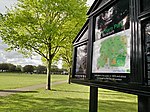Ham House, Newham
Buildings and structures demolished in 1872Buildings and structures in the London Borough of NewhamDemolished buildings and structures in LondonLondon building and structure stubs
Ham House was a building in what is now the Upton Cross area of Newham, east London. It was first recorded in 1670 as Rooke Hall or Rookes Hall, a mid-16th century building, which was later renamed Upton House. Admiral John Elliot sold it in 1762 to John Fothergill, a Quaker doctor and botanist. In the late 1780s it was renamed Ham House to avoid confusion with another Upton House on what is now the corner of Lancaster Road and Upton Lane. Ham House was bought by Samuel Gurney in 1812. It was demolished in 1872 and its grounds opened to the public as West Ham Park in 1874.
Excerpt from the Wikipedia article Ham House, Newham (License: CC BY-SA 3.0, Authors).Ham House, Newham
Mathews Park Avenue, London Maryland (London Borough of Newham)
Geographical coordinates (GPS) Address Phone number Website Nearby Places Show on map
Geographical coordinates (GPS)
| Latitude | Longitude |
|---|---|
| N 51.5417 ° | E 0.0148 ° |
Address
Park Primary School
Mathews Park Avenue
E15 4AE London, Maryland (London Borough of Newham)
England, United Kingdom
Open on Google Maps







